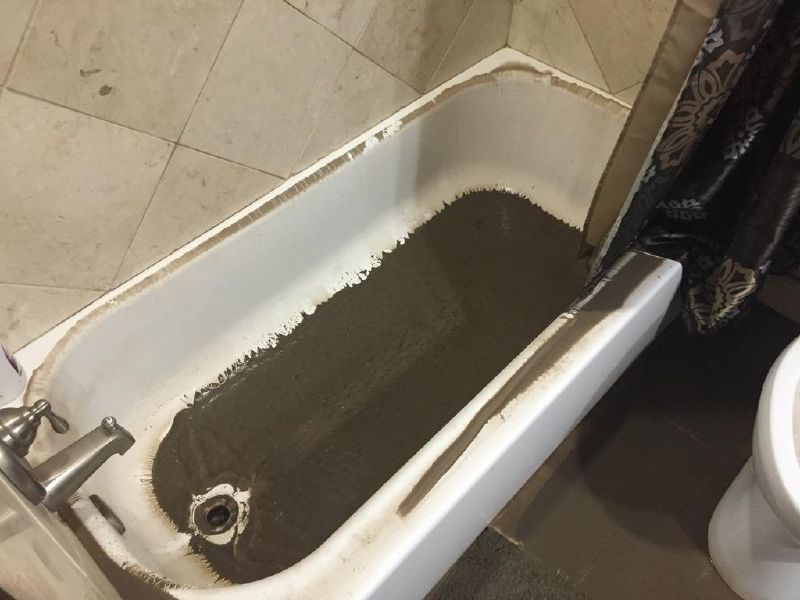Recommended Reasons Behind Discharge Backflow in the Bathtub
Recommended Reasons Behind Discharge Backflow in the Bathtub
Blog Article
This post further down about What to Do if Sewage Starts Coming Up Through Your Bathtub is truly informative. Give it a try and make your own conclusions.

Sewer back-up in the bath tub can be a traumatic and unhygienic trouble for any kind of home owner. Not just is it inconvenient, yet it likewise postures significant wellness threats and suggests underlying problems with the plumbing system. Recognizing why sewer is showing up via the tub is vital for taking proper action to resolve the trouble successfully.
Introduction to the Issue
Usual Factors for Sewer Backup
Blockages in the Sewer Line
Among the most common reasons for sewage back-up is an obstruction in the sewer line. This can take place because of the buildup of debris, grease, or international objects in the pipelines, stopping proper flow and causing sewer to back up right into your tub.
Tree Root Invasion
Tree origins looking for moisture and nutrients can penetrate sewer lines via tiny fractures or joints. Over time, these origins can grow and broaden, causing significant damages to the pipelines and causing sewage back-up concerns.
Comprehending the Issue
When sewer starts backing up right into the bathtub, it's a clear indicator of a problem with the water drainage system. The wastewater that ought to be moving away from your home is instead locating its way back right into your home, which can bring about significant damages and carcinogen.
Potential Reasons
Several aspects can contribute to sewage back-up in the bath tub. From blockages in the sewage system line to issues with the plumbing facilities, recognizing the root cause is necessary for locating a service.
Aging Facilities
Older homes might have outdated plumbing systems that are extra vulnerable to rust, splits, and degeneration. As pipes age, they become extra prone to leaks and clogs, increasing the possibility of sewage back-up incidents.
Heavy Rainfall or Flooding
During periods of heavy rainfall or flooding, the drain system might come to be overloaded with excess water, causing backups and overflows. This can lead to sewage backing up into tubs and various other components inside the home.
Indicators of Sewer Back-up
Foul Odors
Undesirable smells rising from drains pipes or components, specifically in the bathroom, may indicate sewer back-up concerns. These smells are often strong and consistent, signaling a problem that requires immediate focus.
Slow Draining Fixtures
Bath tubs, sinks, and commodes that drain pipes slowly or not at all could be experiencing sewer back-up. If several fixtures are affected concurrently, it's likely that the issue originates from an usual factor, such as the main sewer line.
Gurgling Noises
Strange gurgling or gurgling sounds coming from drains when water is running in other places in the house are a measure of air entraped in the plumbing system. This air accumulation can result from sewer backup and should be examined promptly.
Wellness Dangers Associated with Sewer Backup
Contamination of Water System
Sewage back-up can pollute the water supply in your house, positioning a serious health threat to you and your household. Direct exposure to polluted water can lead to intestinal concerns, skin infections, and other ailments.
Mold and mildew Growth
Wetness from sewage backup can develop ideal conditions for mold and mildew development in your house. Mold and mildew spores can worsen respiratory issues and create allergic reactions in delicate individuals, making timely cleaning vital.
Spread of Condition
Sewage consists of harmful germs, infections, and bloodsuckers that can cause a variety of conditions, consisting of hepatitis, cholera, and gastroenteritis. Entering contact with sewer or infected surface areas puts you in danger of infection.
Cleaning Up After Sewage Back-up
Sanitation Procedures
Extensively disinfect and sterilize affected areas after sewage backup to get rid of harmful bacteria and avoid mold growth. Use suitable cleaning products and safety equipment to make sure risk-free and efficient cleanup.
Restoration of Affected Locations
Fix any kind of damages to flooring, walls, or components brought on by sewer backup. Depending on the degree of the damage, you might need to replace carpets, drywall, or various other materials to restore your home to its pre-loss condition.
Immediate Actions to Take
Switching Off Water System
In the event of sewer back-up, it's necessary to turn off the supply of water to prevent more contamination and damage. Locate the primary water shutoff valve in your home and closed it off till the problem can be fixed.
Contacting a Specialist Plumber
Taking care of sewage back-up is not a DIY job. Call a certified plumber with experience in handling sewage-related concerns to evaluate the scenario and carry out necessary repair services or cleanings.
Preventing Contact with Infected Water
Up until the sewer backup is solved, avoid contact with polluted water to prevent the spread of germs and virus. Use safety gear if you must remain in the damaged area and clean your hands thoroughly afterward.
Safety nets
Routine Upkeep of Sewer Lines
Arrange normal evaluations and upkeep of your sewage system lines to identify and address prospective concerns before they escalate into significant troubles. This can include cleaning out debris, checking for tree origin intrusion, and repairing any type of broken pipes.
Setting Up Bayou Shutoffs
Consider installing backwater valves in your plumbing system to avoid sewage from flowing back into your home during durations of heavy rainfall or flooding. These shutoffs instantly close when water draws back up, securing your residential or commercial property from contamination.
Appropriate Disposal of Family Waste
Stay clear of purging anything apart from toilet paper and human waste down the toilet to stop obstructions and blockages in the drain line. Dispose of oil, oil, and other family chemicals properly to lessen the threat of plumbing troubles.
Why Is Water Backing Up in My Bathtub When I Flush My Toilet?
What to do about a sewer line clog
First, don’t bother with plunging. No amount of plunging will dislodge the clog in a sewer line. The clog is too far away. Plungers are for clogs in the toilet itself, not the sewer line. Plus, the most likely causes of a sewer clog are:
Tree roots Flushed toys or feminine products Grease buildup Those items don’t move easily. And in the case of tree roots, the roots need to be cut out of the pipe and the pipe will need to be repaired.
You’ll need a closet auger. A closet auger is a type of plumber’s snake with a protective cover to keep from scratching the delicate porcelain toilet. If the clog is further down, you may need to remove the toilet or use one of your cleanouts to get to the clog.
We also recommend doing a video inspection of the drain to ensure that the cause of the clog has been completely removed. Otherwise, you could have the same problem again in a few days or weeks.
https://mspplumbingheatingair.com/blog/why-is-water-backing-up-in-my-bathtub-when-i-flush-my-toilet

As a fervent reader about Why sewage is coming up through your bathtub, I figured sharing that piece of content was smart. Sharing is good. You won't know, you could be doing someone a favor. Thanks so much for your time spent reading it.
Suggested Site
Report this page